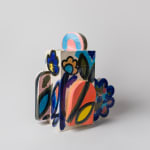





John Booth
Sarah’s Party, 2021
Slab built stoneware urn, hand decorated with slip, clear glazed.
50 x 45 x 23 cm
Copyright The Artist
Further images
John Booth (b.1984) is a Scottish artist working and living in London. His practice encompasses ceramics, collage technique, experimentation with line, embroidery and textile manipulation. Booth learned to make ceramics...
John Booth (b.1984) is a Scottish artist working and living in London. His practice encompasses ceramics, collage technique, experimentation with line, embroidery and textile manipulation.
Booth learned to make ceramics in 2015, taking an eight-week evening course for amateurs at Turning Earth in Hoxton. The artists’ colourful face vases, which have quickly become a trademark, are themselves hybrid objects: part abstract sculpture, part practical vase. They can stand alone as ornaments, but they really come to life when they’re filled with flowers. It takes between two and three days to produce each vase, John explains: “It’s a process called slab building, which is quite fiddly. You roll the clay flat and have pattern pieces, so it’s quite similar to making clothes.” But the construction of each piece is only half the story. Once the clay skeleton is built and fired in the kiln, to what is called bisque, John hand-paints each vase in coloured slip glaze before firing it again, to reveal the finished object.
Booth created stoneware cremation urns decorated with joyful colours and flowers for death specialist Farewill. Booth added three-dimensional flower decorations to the square and rounded ceramic urns and covered the white stoneware with his signature vibrant designs painted with wide brushstrokes. "I made a point of not changing or adjusting any of the colours or materials I use regularly as I wanted the urns to be a continuation of my work and not to be thought of as an anomaly, despite the fact that they definitely sit within a different context than my usual work."
Booth learned to make ceramics in 2015, taking an eight-week evening course for amateurs at Turning Earth in Hoxton. The artists’ colourful face vases, which have quickly become a trademark, are themselves hybrid objects: part abstract sculpture, part practical vase. They can stand alone as ornaments, but they really come to life when they’re filled with flowers. It takes between two and three days to produce each vase, John explains: “It’s a process called slab building, which is quite fiddly. You roll the clay flat and have pattern pieces, so it’s quite similar to making clothes.” But the construction of each piece is only half the story. Once the clay skeleton is built and fired in the kiln, to what is called bisque, John hand-paints each vase in coloured slip glaze before firing it again, to reveal the finished object.
Booth created stoneware cremation urns decorated with joyful colours and flowers for death specialist Farewill. Booth added three-dimensional flower decorations to the square and rounded ceramic urns and covered the white stoneware with his signature vibrant designs painted with wide brushstrokes. "I made a point of not changing or adjusting any of the colours or materials I use regularly as I wanted the urns to be a continuation of my work and not to be thought of as an anomaly, despite the fact that they definitely sit within a different context than my usual work."
Provenance
Artist's Studio31
of
31










